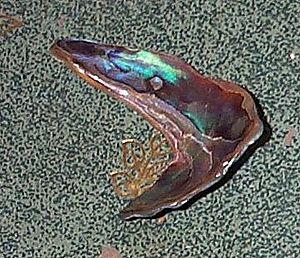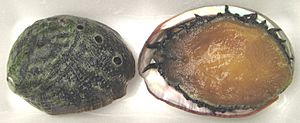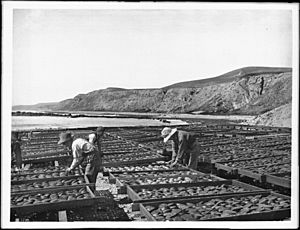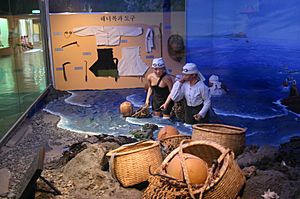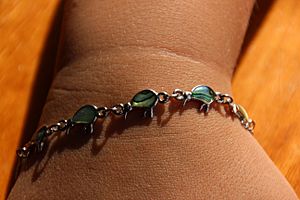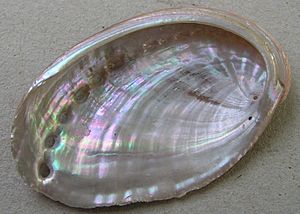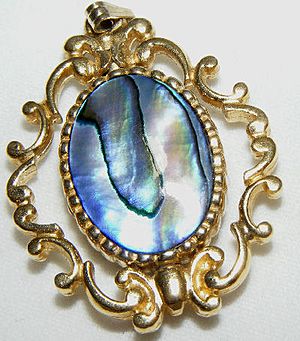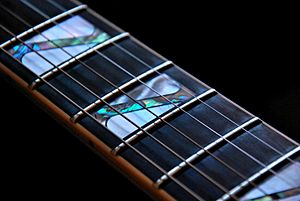Abalone facts for kids
Quick facts for kids Abalone |
|
|---|---|
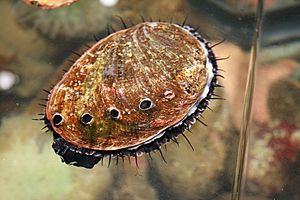 |
|
| A living abalone | |
| Scientific classification | |
| Kingdom: | |
| Phylum: | |
| Class: | |
| Subclass: |
Vetigastropoda
|
| Superfamily: |
Haliotoidea
|
| Family: |
Haliotidae
Rafinesque, 1815
|
| Genus: |
Haliotis
Linnaeus, 1758
|
Abalone are a type of sea snail or shellfish. Their name comes from the Spanish word Abulón.
Abalone are famous for the beautiful, colorful inside of their shells. People in different places have special names for them. For example, they are called "ear-shell" in Guernsey, perlemoen in South Africa, and pāua in New Zealand.
Many people around the world enjoy eating abalone meat. It is a popular food in parts of Latin America (especially Chile), Southeast Asia, and East Asia (like China, Japan, and Korea).
Contents
Discover Abalone: Sea Snails with Shiny Shells
Abalone live in oceans all over the world. You can find them along the coasts of almost every continent. They are not found on the Atlantic coast of South America, in the Caribbean, or on the East Coast of the United States.
Most abalone prefer cold waters. They are common along the coasts of New Zealand, South Africa, Australia, Western North America, and Japan.
What Abalone Look Like
Abalone shells are usually round. They have two or three spirals that grow into a large, ear-like shape. This is why they are sometimes called "ear-shells."
The inside of an abalone shell is very shiny. It can be silvery white, green, or red. This beautiful inner layer is called mother-of-pearl.
Abalone Life and Diet
Abalone can start having babies when they are quite small. They produce many eggs at once, from 10,000 to 11 million!
Young abalone, called larvae, eat tiny floating organisms called plankton. Adult abalone are plant-eaters. They mostly feed on algae, especially red algae.
Abalone can be very small, about 20 millimeters (less than an inch). But some can grow quite large, up to 200 millimeters (about 8 inches).
The Strong Abalone Shell
The shell of an abalone is incredibly strong. It is made of tiny pieces of calcium carbonate. These pieces are stacked together like bricks. Between these layers is a sticky protein substance. This special structure makes the shell very tough.
The colorful inside of the abalone shell is often used for decoration. It can be made into beautiful inlays for things like guitars.
Harvesting Abalone: Where and How
People around the world harvest abalone for food and their shells. However, rules are in place to protect them.
Abalone in Australia
Tasmania, an island in Australia, provides about 25% of the world's yearly abalone harvest. Around 12,500 people in Tasmania fish for blacklip and greenlip abalone for fun.
Abalone in the United States
In California, people can catch red abalone for sport. You need a fishing license and an abalone stamp card.
The abalone season usually runs from May to October, but not in July. It is against the law to sell abalone caught for sport, even their shells. Only red abalone can be taken. Other types, like black, white, pink, flat, green, and pinto abalone, are protected by law.
People who dive for abalone often wear thick wetsuits, including a hood, boots, and gloves. They also use a mask, snorkel, weight belt, an abalone iron, and a special gauge to measure the abalone.
Sometimes, people can find abalone by feeling under rocks at low tide. Abalone are usually found in shallow waters, from a few inches to about 10 meters (33 feet) deep. Some skilled freedivers can go even deeper.
Abalone are often found on rocks near their food sources, like kelp. Divers use an abalone iron to carefully pry the abalone off the rock before it can clamp down tightly. Divers can go from boats, kayaks, floating tubes, or directly from the shore.
Abalone in New Zealand
In New Zealand, abalone are called pāua, which is a Māori language word. The "blackfoot pāua" found in New Zealand has a very shiny shell. This shell is popular for souvenirs because of its amazing blue, green, and purple colors.
If you are fishing for fun in New Zealand, you do not need a special permit to catch pāua. However, you must follow rules about how many you can catch, their size, and any seasonal or local limits. These rules are set by the Ministry for Primary Industries (MPI).
Abalone in South Africa
The largest abalone in South Africa is called Haliotis midae. It lives along about two-thirds of the country’s coastline.
Diving for abalone has been a popular activity for many years. However, the number of abalone is now at risk because of illegal commercial harvesting. In South Africa, everyone who harvests abalone needs a permit that is given out each year. It is also against the law to use scuba gear to catch abalone.
Abalone in the Channel Islands
The Haliotis tuberculata abalone is considered a special food in the British Channel Islands and nearby parts of France.
Because of too much harvesting and a recent disease, the number of these abalone has dropped a lot since the late 1800s. Now, strict rules are in place to help protect them.
Decorative Uses of Abalone Shells
The very shiny inner layer of the abalone shell has been used for decoration for a long time. It is made into jewelry, buttons, and inlays for furniture and musical instruments like guitars.
Abalone pearl jewelry is very popular in New Zealand and Australia. This is partly because pearl companies have worked hard to market and farm them.
Unlike other pearls, abalone pearls are not judged by how round they are. The inside of the abalone shell has an amazing iridescent swirl of bright colors. These colors can be deep blue, peacock green, purple, cream, and pink. This means that every abalone pearl, whether natural or farmed, will have its own unique mix of colors.
Abalone in Native Cultures
Abalone has been an important food for native cultures around the world. This is especially true in Africa and on the North American West coast. The meat was eaten, and the shells were even used as money by many tribes.
Abalone Farming
People have tried to grow abalone in special farms for eating. This process is called aquaculture.
Images for kids
-
Multi-Species Fish and Invertebrate Breeding and Hatchery, (Oceanographic Marine Laboratory, Lucap, Alaminos, Pangasinan, Philippines, 2011)
-
Haida carving with rectangular abalone shell accents
-
Abalones with asparagus
-
Abalone Hoe
-
Abalone with mandarin orange peels.
-
Abalone (dish) - in Macau
-
The black abalone, Haliotis cracherodii
-
The white abalone, Haliotis sorenseni
See also
 In Spanish: Bào yú para niños
In Spanish: Bào yú para niños


